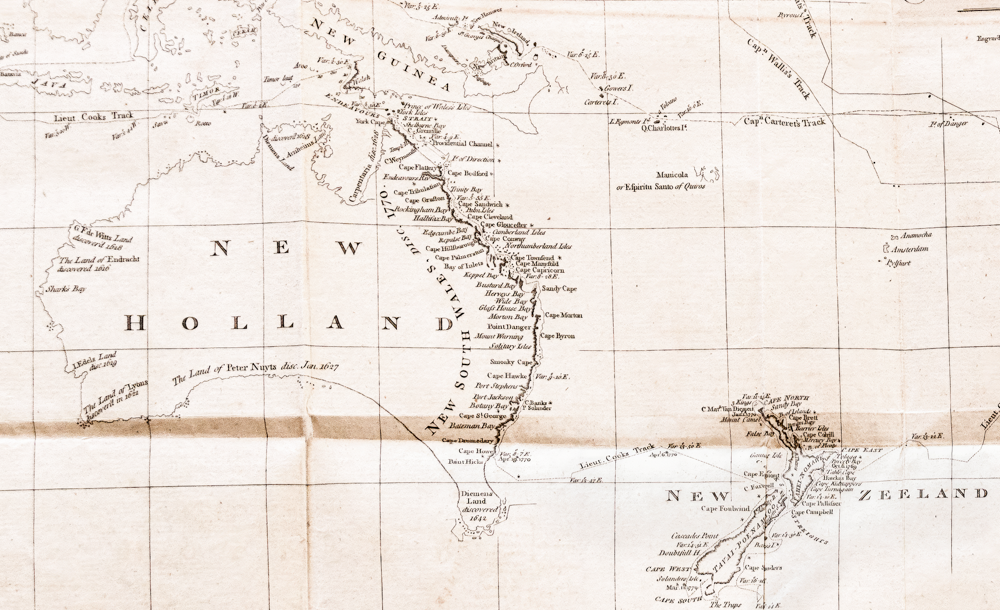
Parkinson was Sir Joseph Banks' "draughtsman" on James Cook's expedition to Tahiti, New Zealand and Australia 1768 - 1771. This journal is based on the notes he made during the voyage and was published by his brother Stanfield after Sydney's death on the voyage home. The illustrations are engravings made from Parkinson's original sketches.

Sydney Parkinson was born in Scotland in 1745 and showed early talent in drawing and painting botanical subjects. He exhibited at the Free Society in London in 1765 and 1766 and was commissioned, with others, by Joseph Banks to prepare paintings from his 1766 Newfoundland and Labrador collections.
Parkinson was then retained by Joseph Banks to sail with Cook on His Majesty's ship the Endeavour to observe the transit of Venus in Tahiti and explore New Zealand and the east coast of Australia. They sailed from Plymouth on 25 August 1768 calling at Madeira, Rio de Janiero and Tierra del Fuego before sailing across the Pacific Ocean reaching Tahiti 13 April 1769. At every stop they collected specimens of plants and these were all drawn or painted by Sydney Parkinson in meticulous detail.
The Endeavour then sailed around New Zealand and up the east coast of Australia to Batavia, Java. Here the conditions were very unhealthy and the water foul and it is thought that this was where Sydney Parkinson contracted dysentery which led to his death at the age of 26 on the voyage home.
Although only a young man of twenty-three when he set out on Cook's voyage, Parkinson was remarkably productive. It is estimated he made some 276 finished and 676 unfinished drawings of plants, 83 finished and 212 unfinished drawings of animals and about 100 other drawings of people, boats and scenery. Of Australian plants Banks had 362 finished paintings prepared from Sydney Parkinson’s sketches. This journal does not include pictures of plants but gives a description of - "Plants of use for Food, Medicine etc. in Otaheite".
Parkinson's magnificent drawings and paintings of plants were used by Sir Joseph Banks to make the copper plates for the engravings for his massive Florilegium although this was not published until 1990. Banks had 362 finished paintings prepared from Parkinson's sketches of Australian plants and plant specimens that had been preserved.


RGSSA catalogue rgsp 910 41 P248c -two editions (located in the glass-fronted cabinet)
The Parkinson family were Scottish Quakers and brewers from Edinburgh. After his father Joel died, Sydney, his mother Elizabeth, brother Stanfield and sister Britannia moved to London. There he met Joseph Banks. After Sydney had worked on the zoology of Banks' expedition to Newfoundland and Labrador, Banks offered Sydney a position as artist on Cook's voyage around the world with the Endeavour.
Banks was extremely wealthy and financed the scientific side of the expedition - he was an avid collector and recorder of botanical specimens. Sydney Parkinson produced many fine drawings for Banks not only of plants and animals but also of the people and things that he saw on the voyage. The illustrations in these journals are black and white engravings based on Parkinson's partially coloured pencil sketches. Unfortunately Parkinson died of dysentery at Cape Town on the journey home and his brother Stanfield edited his papers and published this journal in 1773.
Due to his death Parkinson's actual journal was lost and there were disputes over the ownership of his papers. In the event his brother used Sydney's notes and published the first issue of the journal in 1773 after considerable unpleasantness. Eleven years later in 1784, the second volume was published by John Fothergill, with various contributors - including Captain Cook. The RGSSA has both these editions.
The engravings by Sydney Parkinson in this journal are attributed as " S. Parkinson, del " in the bottom left - hand corner and the lithographers either "J. Chambers Sc." or "R.B.Godfrey Sculp. " in the bottom right -hand corner.
Reference RGSSA catalogue - rga 743.7 P 248 S
Carr D. J. ed. Sydney Parkinson, Artist of Cook's Endeavour Voyage. Published by British Museum (Natural History) in association with Australian National University Press, Canberra,1983.
The process of preparing fine prints is as follows. The artist prepares a sketch of the plant, bird or animal often in difficult circumstances out in the weather or on the deck of a rolling ship. These are then turned into finished coloured paintings by some other artists. These in turn are used by the engraver to prepare the copper plates or in the case of lithography the lithographic stone. The printer then runs off the number of prints required and these are then hand coloured by others known as "colourists”. The finished prints can then be issued to subscribers either loose or bound in volumes.
© The Royal Geographical Society of South Australia